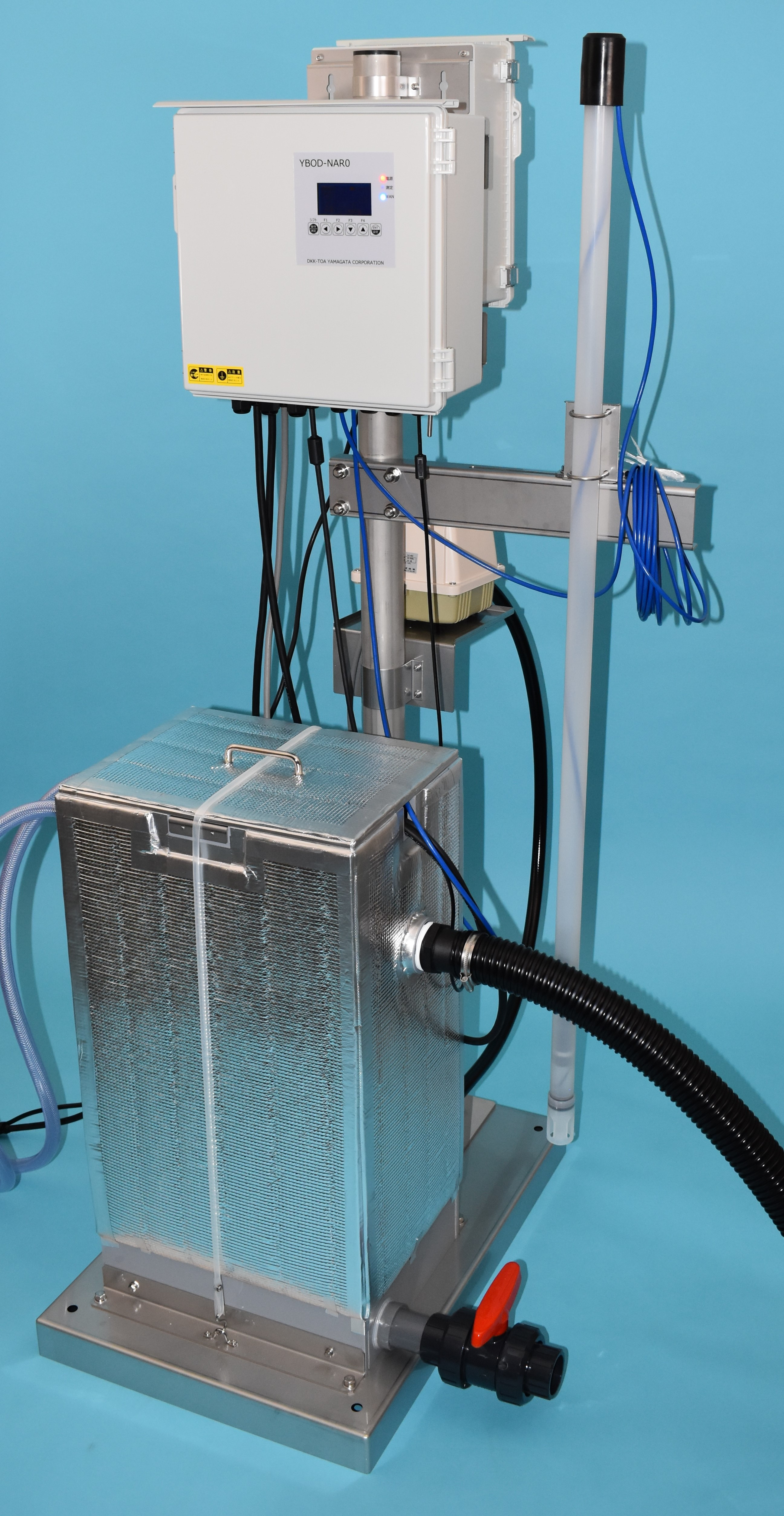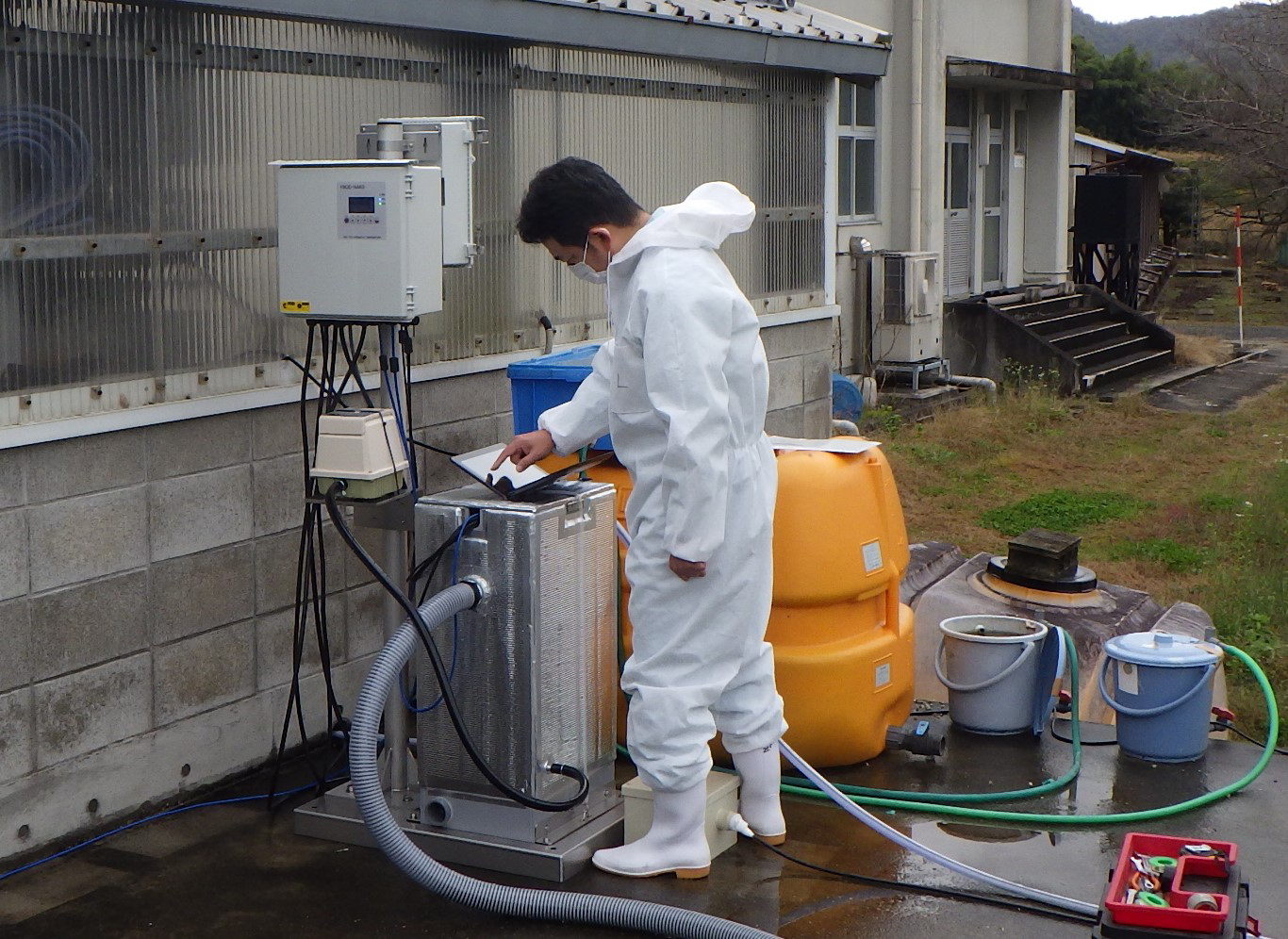In order to realize sustainable pig farming management, it is important to preserve the water environment in the pig farming area, and there is a need for technology to efficiently purify the pig farm wastewater. As a solution, a revolutionary wastewater treatment monitoring system using electricity-producing bacteria was developed by the Institute of Livestock and Grassland Science, NARO (NILGS) and DKK-TOA Yamagata Corporation. It is possible control the purification treatment device while measuring the degree of contamination of wastewater in a short time, and the information can be viewed on a smartphone. It is also possible to comply with nitrogen wastewater standards, which are becoming stricter year by year. Future spread among pig farms nationwide can be expected.
BOD measurement reduced from 5 days to 6 hours
The activated sludge process is widely used as a method of purifying wastewater from livestock farms so that it can be discharged into rivers, etc. It is a method of aeration that sends air into wastewater to activate the action of microorganisms and remove and decompose pollutants such as nitrogen. The problem with this treatment method is that when conventional methods are used, it takes approximately five days to measure biochemical oxygen demand (BOD), which is an indicator of how dirty the wastewater is, and there is no efficient way to aerate according to the degree of dirt in the wastewater, which fluctuates daily.
The Institute of Livestock and Grassland Science, NARO (NILGS) and DKK-TOA Yamagata Corporation have developed a BOD monitoring system that significantly shortens the measurement time of BOD to about 6 hours, leading to the realization of efficient wastewater treatment.
Correlation between the amount of electricity generated by electricity-producing bacteria and BOD
Electricity-producing bacteria play a major role in this system. Electricity-producing bacteria is a general term for a group of bacteria that generate an electric current when decomposing organic matter, and they live widely in the natural world, such as wastewater from livestock barns, soil, and the intestines of animals.
Hiroshi Yokoyama, senior researcher at the Institute of Livestock and Grassland Science, NARO (NILGS), clarified the correlation between the amount of power generated by electricity-producing bacteria and BOD, and devised a device to monitor the BOD values from the amount of electricity generated. DKK-TOA Yamagata Corporation has commercialized this device as a system that can be used at the wastewater treatment site of pig farms (Fig.1). Wastewater is poured into this system, and the BOD value is measured based the amount of electricity generated by the electricity-producing bacteria in it. As a result, it became possible to know the BOD value in approximately 6 hours. Moreover, the aeration operation is automatically turned on and off based on the BOD value.

|
| Fig.1 BOD monitoring system using electricity-producing bacteria (Provided by DKK-TOA Yamagata Corporation) |
[Notification to smartphone once daily
This system is connected to the Internet, and the fluctuating BOD value in the aeration tank is saved on the server once per day and can be checked on a smartphone. This reduces the need to go to the site each time, and even if management is outsourced to an external company, it saves on patrol management costs.
Electricity costs reduced by about 30% in demonstration experiment
Another major advantage is the ability to save electricity on wastewater treatment. The cost of aeration accounts for half of the running cost of wastewater treatment, but the BOD monitoring system reduces wasteful aeration time. When tested at four pig farming wastewater treatment facilities, including the Yamagata Integrated Agricultural Research Center, the aeration time was reduced by about 30% compared to conventional methods, and the electricity bill was reduced by about 13,000 yen per month per 100 sows. Approximately 30% cost reduction was demonstrated even when considering total maintenance cost.
Compliance with strict future wastewater standards can be expected
It is also attractive point that the device can respond to wastewater regulations that are becoming stricter year by year. In July 2019, the provisional wastewater standard value for nitrogen (nitrate nitrogen, etc.), which leads to eutrophication of lakes and marshes, was lowered from 600mg/L to 500mg/L for livestock industry wastewater. It can be expected that this value will eventually be lowered to 100mg/L, which is the general wastewater standard value. The BOD monitoring system is indicated to be able to achieve a value of 100mg/L or less if proper management conditions are in place.
DKK-TOA Yamagata Corporation won the "TOHOKU DX Award" Excellence Award
In November 2021, DKK-TOA Yamagata Corporation, which developed the BOD monitoring system, won the Excellence Award (product and service category) of the TOHOKU DX Grand Prize sponsored by the Tohoku Bureau of Economy, Trade and Industry. The award was won for "the development of a livestock wastewater treatment monitoring system that enables remote monitoring and control using IoT." It was also highly evaluated for its technology that enables telework during the COVID-19 crisis by utilizing the Internet of things (IoT), which allows two-way data exchange between objects.
The system will go on sale from July 2021 and can be installed in existing purification plants (Fig.2). The price is about 2,600,000 yen with functions such as IoT (installation cost is not included). It has also been reported that maintenance and management costs can be reduced by several tens of thousands of yen per month for small-scale breeding; even if the amortization period of the device is assumed to be 10 years, the price is considered to be sufficiently affordable. Orders have already been received from several pig farms, and further spread is expected in the future.
 |
| Fig.2 Installation and adjustment work for the BOD monitoring system at the Tottori Swine & Poultry Experiment Station (Provided by DKK-TOA Yamagata Corporation) |
Project name
The special scheme project on vitalizing management entities of agriculture,forestry and fisheries
Project period
FY 2017 to 2019
Title
Development of nitrogen removal system for pig farm wastewater using BOD biosensor
Leading research institutes
Institute of Livestock and Grassland Science, NARO (NILGS), DKK-TOA Yamagata Corporation, Maruyama Co., Ltd., Reselber Co., Ltd., Yamagata Integrated Agricultural Research Center, Chiba Prefectural Livestock Research Center, Kumamoto Prefectural Agricultural Research Center, Miyazaki Prefectural Livestock Experiment Station, Okinawa Prefectural Livestock Research Center
